
Home Technology Guide (2024)
How to make a smart plan for technology in your new home.
Table of Contents
You’re finally building your dream home. You’ve hired an architect, and you’re shopping around for the perfect builder. You may not know it yet, but this is the ideal time to involve a home technology integrator.
What exactly is an integrator? An integrator is the designer and installer of your home’s technology backbone. Their primary mission is to create audio and video experiences like music throughout the house, TV installations, and home theater. An integrator brings together all of the separate systems in your home like lighting, HVAC, and security, and makes them more manageable by providing one cohesive control system.

While smaller spaces can be easily managed with off-the-shelf solutions like Apple HomeKit or SmartThings, it’s usually a huge benefit to call in an expert as the home’s size grows.
It’s important to talk through your options early on because, while you can retrofit some things after the house has been completed, it’s dramatically less expensive to pre-wire your home during construction.
IF THERE’S EVEN THE SLIGHTEST CHANCE YOU MIGHT WANT SOMETHING IN THE FUTURE, RUN THE WIRE DURING CONSTRUCTION!

LASTLY, WHILE IT MAY BE TEMPTING, DON’T RELY ENTIRELY ON WIRELESS.
Wi-Fi has come a long way, but if you have the opportunity to pre-wire for any device, like a computer or TV, you should do so. This forward-thinking frees up your wireless network to provide the best service for devices that move around throughout the home (phones, tablets, etc.) and gives you a little bit of a backup plan if you need to add something later on that can’t be hardwired.
WHOLE-HOME AUDIO
One of the biggest trends in building today is the use of a whole-home audio system. If you’ve ever wanted to have music playing throughout your home (without deafening anyone who dares to walk in the living room), then this is the solution for you.
Some of the more popular brands you’ll probably run into are Sonos & BlueSound, but you may occasionally see others. Speakers are installed in ceilings and walls, but soundbars and freestanding speakers can also be integrated. You can stream music from the provider of your choice or even listen to vinyl from your turntable.
Once these speakers are in place, it doesn’t just stop at music. With a bit of further design, you can use these speakers to carry sound from your TV, broadcast the doorbell, or even function as an intercom.
THINK IT THROUGH:
Not every space needs the same quality of sound. Work with your designer and figure out the places where quality counts. Come up with a Good, Better, Best strategy.
This method lets you focus your investment on areas where you’ll be congregating, like a kitchen or living room, but allows you to use more economical options in transient spaces like hallways or bathrooms

TYPES OF SPEAKERS:
Let’s take a moment to make sure you have a clear understanding of the different types of speakers that are available. For purposes of discussing your new home, we can break those down into three main categories.
IN-CEILING & IN-WALL
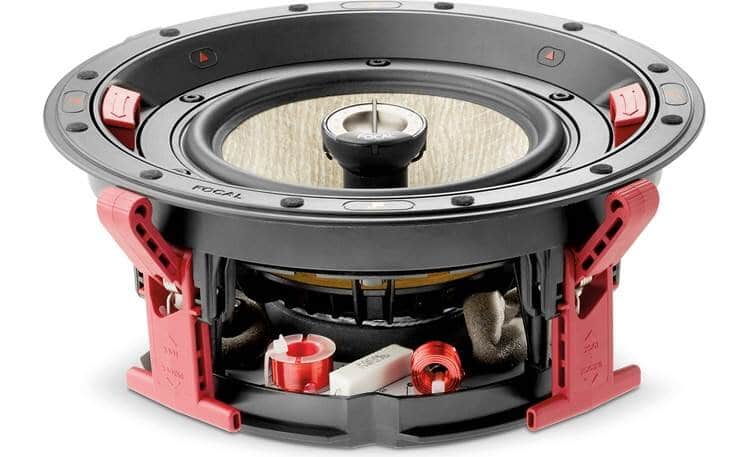
In-Ceiling or In-Wall speakers are exactly as their names describe, but you’ll sometimes see them called “Architectural Speakers.” They’re speakers that are tucked away into your wall or ceiling and can provide rich sound without eating up floor space or providing an easy target for a Sharpie-wielding toddler or teething chihuahua. When people think of speakers in a smart home today, these are what come to mind.
In-Ceiling is a perfect solution when you’re looking for “heard and not seen.”
One caveat to be aware of: depending on the particular speakers you’ve selected, they can sometimes be lacking in bass response, but the addition of a subwoofer can quickly remedy this.
TIPS & TRICKS:

Specify in-ceiling speakers with a “rough-in” bracket that acts as a template for your drywall crew. This bracket allows you to line up speakers with other elements on the ceiling, like recessed lights or other points of interest. These brackets are cut out as your drywall is installed, leaving a perfect hole and no mess in your home later on.
Are you concerned about sound from speakers in one room bleeding into the room behind it or the floor above? Install a back box. A back box is an enclosure that installs behind your speaker and blocks the sound from traveling into adjacent rooms; it also provides a slight boost in audio quality.
SOUNDBARS:
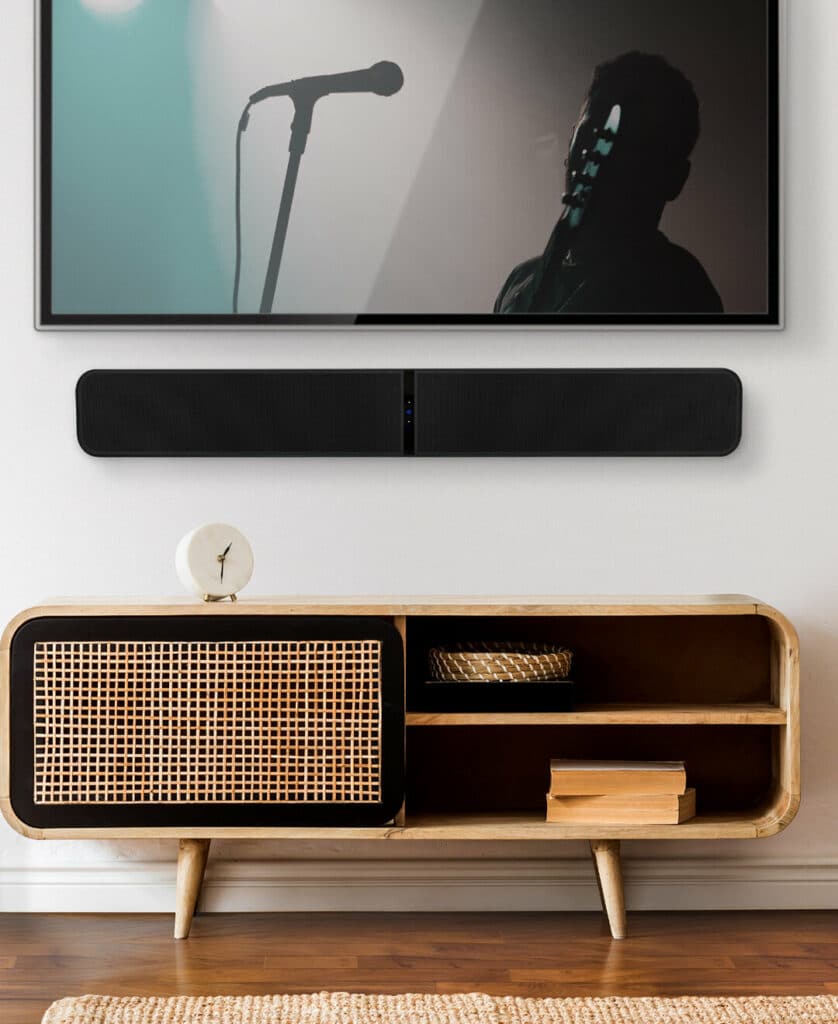
Everyone knows the built-in sound from your TV leaves much to be desired. You can only expect so much from a pair of tiny speakers shooting backward into your wall. That’s where Soundbars come in. They provide a simple upgrade from your TV’s internal speakers without much of the fuss of larger speakers.
Due to their compact size, they can’t match the performance of in-wall or freestanding speakers, but they’re a great starting point and perfect for spaces like bedrooms or an office.
FREE STANDING / FURNITURE PIECES:

While they’re no longer as common as their in-wall brethren, sometimes freestanding speakers are a perfect choice. Since the enclosure the speakers live in can be engineered for performance, freestanding speakers are the pinnacle of audio quality. They don’t have to be ugly either; speakers from brands like Focal or KEF are available in a wide range of finishes and can genuinely give your interior designer something unique to work with.
I like to think of some of these high-design pieces as furniture and not just a source of sound. There’s no better way to say “listening room” than a bold pair of speakers commanding your attention. The downside to freestanding speakers is they do eat up floor space, but sometimes quality is worth the compromise.
SUBWOOFERS: ‘CAUSE YOU’RE ALL ABOUT THAT BASS:

One final speaker serves as a faithful companion to all three types we’ve listed above. Subwoofers reproduce low frequencies and bass in a way that most normal speakers aren’t able to. Subs are the secret sauce that makes you FEEL the music. It takes a substantial speaker to create that energy, so most subwoofers clock in between ten and sixteen inches in diameter.
A subwoofer is an absolute must for a home theater, but you should also consider using them in entertaining spaces or living rooms.
HOME THEATER
So what exactly is a home theater? A home theater can be any space that offers a few key ingredients. The size and appearance can vary, but they always employ some kind of multi-speaker surround sound system and a high-quality display. The main idea is to bring some of the magic and allure of a commercial movie theater right into the comfort of your own home.


WHAT TYPE OF DISPLAY IS BEST FOR YOU?
There are two primary display technologies available today; Flat-panel TVs (LCD & OLED) and Projection systems.
The first thing to decide is what size screen is appropriate for your space. When a screen is too small, you won’t be drawn into the action or might find yourself squinting. Conversely, if a screen is too large, it will overwhelm the space and cause you to tilt your neck to take in the entire scene.

A RULE OF THUMB:
WE RECOMMEND THE FOLLOWING SCREEN SIZES BASED ON THE ROOM TYPE:
Bedrooms: 55″
Home Offices, Living Rooms, Great Rooms : 55″-77″
Media Rooms & Custom Theaters: 82″ – INFINITY! (Seriously!)
Additional Resources:
If you want to make sure you get things right, use a screen-size calculator from THX or SMPTE. Input the distance between your seating position and the screen. The calculator will suggest the perfect screen size for your room.
VIEWING ANGLE
When you sit straight in front of a screen, this is called on-axis viewing. Most displays perform their best when viewed on-axis, but as you move to the left or right of center (off-axis), some types of TVs are prone to washing out and losing contrast. If a wide viewing angle is required, consider a TV based on OLED technology. It might cost a little bit more, but in the end, you (and all your guests) will be much happier with the experience.
A wide viewing angle can be one of the primary differences between a cheap TV from a big box store and the available higher-end models. Sure, it’s great to save a couple of bucks if you can, but that doesn’t matter if it isn’t usable in your space.
WILL IT PLAY NICE WITH OTHERS?
An essential but often overlooked piece of the puzzle when selecting a display has nothing to do with picture quality, screen size, or aesthetics. To integrate with most home control systems, a TV has to support network control.
If you select any mid-range or higher models from Sony or Samsung, you should be safe, but picking a TCL or Vizio could leave you banging your head against the wall.
FLAT PANEL OR PROJECTOR?
Once you’ve settled on the appropriate screen size, let’s look at which technology might be the best fit. Believe it or not, it’s a pretty easy decision!
If you need a screen larger than 85 inches, you’re going to need a projector. For any application smaller than 85 inches, keep things simple and stick to a flat panel.

PROJECTORS : THE REALLY BIG SCREEN

Projection setups have one huge advantage compared to flat-panel TVs, and that is the ability to accommodate enormous screen sizes. Nothing else can even come close to their ability to put you right in the middle of the action. When you’re looking for the wow factor, a projector delivers!
But, there are a few factors that come with the territory…
The most significant enemy to any projection setup is ambient light. When stray light from the outdoors hits your screen, it causes it to lose contrast and punch but fortunately, there are a few creative solutions that can help mitigate the problem.
The first line of defense is to address the source of the light itself. You can pair a home control system with motorized shades and automated lighting control. With a single press of a button, you can turn on the projector, dim the lights in your room, lower the shades and start your movie.

Companies like Screen Innovations have worked miracles to solve these kinds of problems with new screen materials like “Slate” or “Black Diamond .” These screens brilliantly display the image coming from your projector while rejecting most of the ambient light in the room.
But wait, that’s not all!
Have you ever wondered where all the bulky speakers are hiding in a movie theater? If you’ve taken in a showing at the IMAX, you’ve probably seen the demo where they illuminate the screen from behind to reveal the colossal stacks of speakers hiding behind the screen.

When you use what’s called an “Acoustically Transparent” or AT screen, you can benefit from the same thing at home. An AT screen has thousands of tiny perforations that allow sound to pass through unencumbered while visually hiding anything concealed behind it.

This is a perfect option for people who want big-league sound without seeing where it is coming from.
DON’T BE AFRAID TO DREAM BIG
Almost anything is possible with projection.
You can hide motorized screens in ceilings or drop one down in front of a smaller TV for casual use!
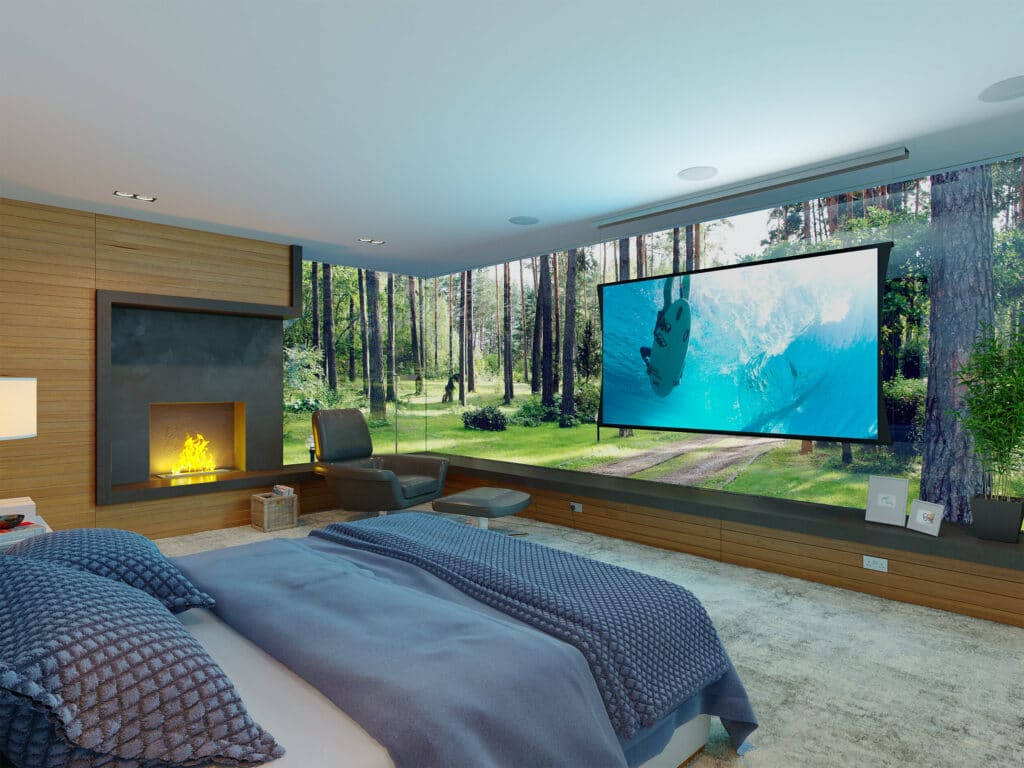
A CLOSER LOOK:
SURROUND SOUND FOR HOME THEATER
If you want to get more information on the basics of Surround Sound check out our blog post “Surround Sound Basics” here!
MOTORIZED SHADES & CURTAINS
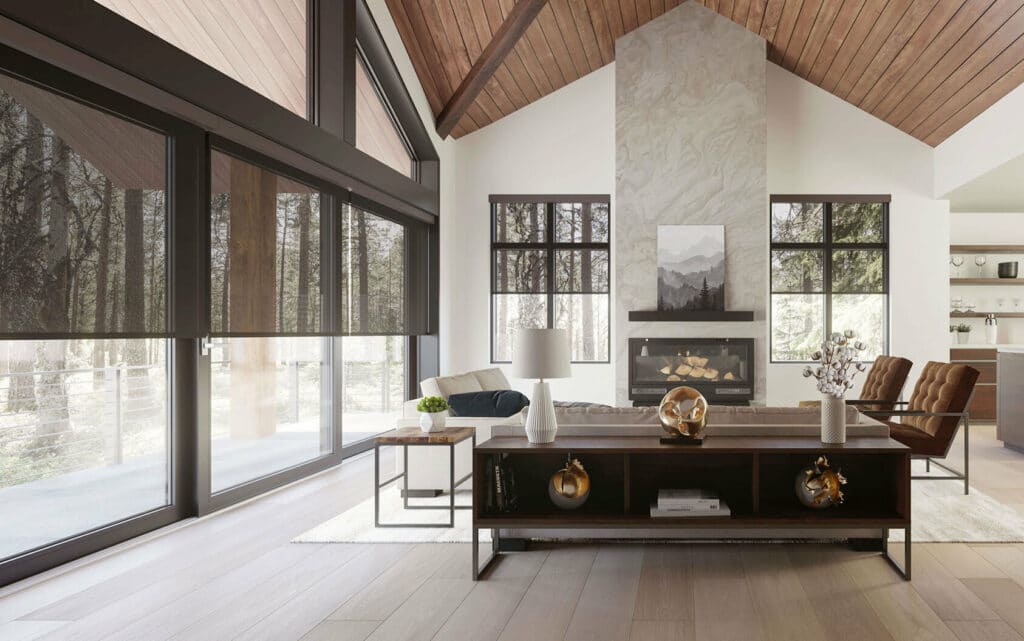
If you ever wished that one day you could press a button and completely transform the feeling of a room, the future is here, and such technology is no longer just reserved for the likes of Tony Stark, James Bond, or Richard Branson.
Motorized shades serve multiple purposes like controlling the amount of light inside the room, helping control solar heat gain, and offering privacy on demand.
MATERIAL TYPES
There are three primary categories of shade materials. “solar screen” fabrics allow a specific amount of light to pass through while offering a screened look. You’ll usually see them written as with a percentage value, representing the amount of light that is allowed to pass through the material.

“Blackout” fabrics, while entirely opaque, offer the most significant amount of privacy and temperature control.

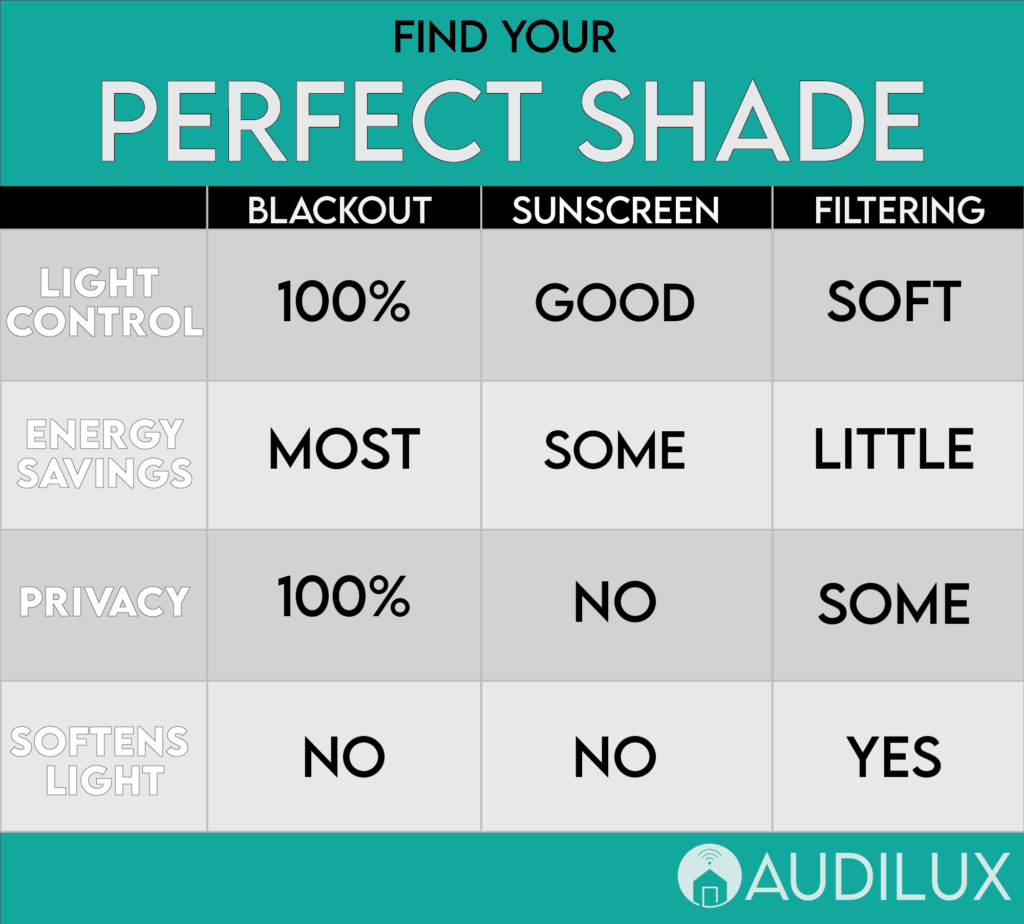
TIPS & TRICKS FOR MOTORIZED SHADES:
When selecting a light filtering fabric, choose darker colors for enhanced viewability and lighter colors to help maximize heat reduction.
AS ALWAYS, IT PAYS TO PREWIRE.
In a remodel situation, installations are usually limited to using lithium batteries that require an annual recharge. When planning for new construction, be sure to specify a prewire to make your shades virtually maintenance-free.
Lighting Control & Automation
Lighting control is also one of those most natural and valuable ways to automate your home. Each bank of lights can be assigned to scenes or schedules., and you can even make walking around the house on the way out the door a thing of the past.
You have three options to consider when it comes to controlling the lighting.
#1 – Smart Dimmers or Switches

The traditional way is to install “smart” dimmers throughout the home. Each light or “Load” is wired directly to a dimmer switch in each room. This can save on wire costs for your electrician, but in larger homes that have multiple switches for each space, it can certainly get ugly. The advantage of this method is cost. Depending on which platform you use, like Lutron RA or Z-Wave, you could only be looking at a premium of $50-$100 per dimmer location.
#2 – Wi-Fi Bulbs

The second option is the use of wi-fi bulbs. With an app on your phone or tablet, the lights can be programmed with different flash patterns and color schemes if you’re feeling adventurous.
There are a few negatives to opting for individual smart bulbs, one being their significant price premium. Also, if you choose bulbs using wi-fi technology, they’re notorious for slowing down wi-fi traffic and crowding your network.
#3 – Panelized Lighting

The last type of lighting control is the most intensive but also has a few very distinct benefits.
Panelized lighting is the gold standard in custom lighting control.
In a typical home, light switches are installed directly in each room, and the individual fixtures or loads connect directly to them. This traditional approach is simple and does offer savings on wiring costs.
When you make use of panelized lighting, all switches and dimmers are located in a central panel (usually in your home’s mechanical room) and then remotely controlled.
This configuration does require a little more wire and planning, but the payoff is enormous. For example, you can have six loads controlled in the space, typically used for only one, or eliminate mechanical switches and centralize control on a touch panel.
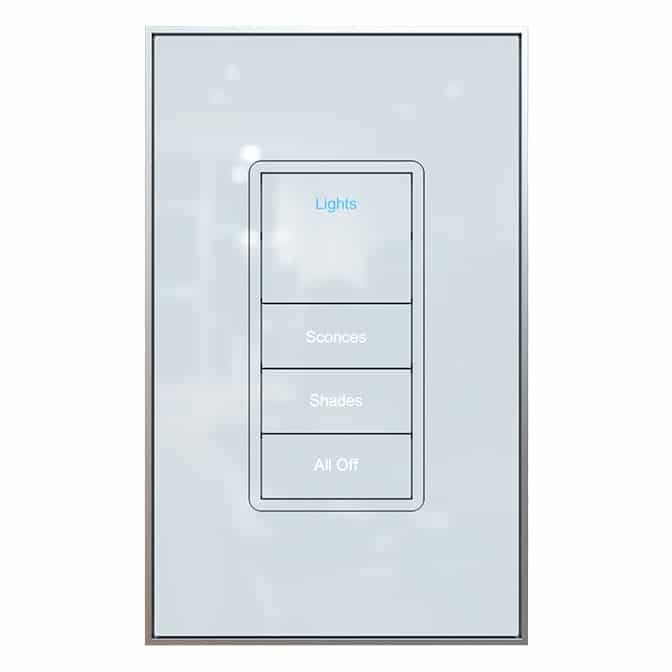
If you want to get a deeper look at lighting control, take a look at our post on Lighting Control & Humancentric Lighting.
Take control with a home automation system
We’ve talked about some of the things you can do with technology in your new home, but what’s the best way to bring everything together and make it a functional and useful part of your everyday life? The use of a home control system makes integrating all of the various technology in your house user-friendly and effortless.
You’ve probably heard of some of the DIY brands in the space like SmartThings, or Apple Home Kit. On the professional side, some of the bigger players are Control 4, Savant, Crestron, and Elan. When you’re working with a smaller home or just a few devices, sometimes the big box brands are completely adequate.
If you’re controlling every aspect of your home or just have a lot of technology, you’re much better off with a professionally installed solution.
At Audilux, we’ve standardized all of our installations around Elan. We think it’s the very best option on the market for custom homes and provides a great balance of elegance and value.

One of the biggest differences between a custom system and DIY alternatives is that all of the processing is done right inside your home rather than sent off to the internet. This is called “Local Control” and it offers a huge advantage in both security and performance. Imagine asking a question from across the room rather than being forced to walk ten miles just to get an answer; I think we’d all choose the simpler option.
This also means that in the event your internet connection is down, everything continues to function normally. This is not true of store-bought solutions.
Remember, Nothing you see is a coincidence.
There is a lot more than just good technology going into the images of theaters you see on Pinterest or in Magazines. It takes a lot of work from talented interior designers coordinating with your general contractor and your technology professional to achieve those kinds of results.
If you have something in mind, bring it up early so everyone who needs to be involved can do their part to make your dream come to fruition!
F.A.Q.
What’s a realistic Budget for technology in my home?
You can use our budget calculator to get a rough idea of how to plan for the cost of technology in your home. Just input you’re home’s square footage and answer a few simple questions.
How do I choose the right Technology company for my new build?
The technology in your home is something you’re going to interact with every day, and finding the right team to partner with is a big decision. First, realize that not all companies are created equal, and the expected service level can vary greatly. Look for companies that are certified by the Home Technology Association.
Less than 10% of integrators make the cut, and you can trust that anyone certified has been through a rigorous vetting process. If you’re in Nashville or Middle TN, we’d love to work with you with you on your project.
PLEASE DON’T HESITATE TO REACH OUT!
PROUDLY SERVING: BRENTWOOD, FRANKLIN , NOLENSVILLE, BELLE MEADE , NASHVILLE & MORE